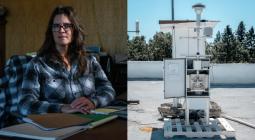How ponds tell story of the air pollution around them

A researcher has been looking for evidence of past air pollution in the mud of ponds in Merseyside
Understanding air pollution of the past may be key to explaining some of the health inequalities that persist between different parts of the UK. Paintings by Lowry, Constable, Monet and Turner show how our skies were often filled with haze and smoke, but we have few measurements to understand how much pollution was in the air and what it was made of.
Dr Ann Power, of the University of Exeter, has been looking for evidence of past air pollution in the mud of urban and agricultural ponds. “We wanted to understand how exposure to urban air pollution has changed over the last 200 years as our towns and cities have evolved since the Industrial Revolution. We focused on the Merseyside region due to its industrial past and present-day high rates of long-term illness,” she said.
Investigations of historical air pollution often involve considerable creativity. Previous studies have tracked air pollution through the early 20th century by examining the soot-stained feathers of stuffed birds from museum collections, and others have used 18th-century measurements of the electrical properties of the atmosphere made by amateur weather enthusiasts.
In her research, Power paddled a small inflatable boat around ornamental and agricultural ponds in Merseyside. All were present in maps from the 1800s. The largest was less than half the size of a football pitch, and the smallest were less than a few metres across. She used ropes to tether her boat in the middle of each pond and carefully leaned over the side to drill into the sediment.
Individual ponds told the story of the air pollution around them, but many trends were common across the whole region. Lead was found in the pond muds. This increased rapidly from the 1970 sediment until lead additives in petrol were controlled and finally banned in the late 1990s.
Sulphur in the pond mud declined from the 1970s, reflecting the slow rollout of smoke control areas, the availability of fossil gas to replace coal and progressive controls on industry. Zinc and copper could be matched to the opening of foundries and the modern expansion of vehicle manufacturing. Fly ash particles reflected the operations of former coal-fired power stations, including those at Bold and Fiddlers Ferry.
Oglet pond is smaller than a tennis court and is located in a field close to the runway of Liverpool’s John Lennon airport. The airport was opened in 1933, with a converted farmhouse as a terminal building. It is much busier today. Passenger numbers have increased nearly tenfold since the 1990s and the impact can be seen in the lake mud. Power found a distinct change in the magnetic properties of particles found in the sediment since 1995, which now match the types of particles produced from aircraft engines.
Notable across all of the ponds was a change that took place in the 1980s with the shift to smaller combustion-derived particles exposing people to a form of air pollution not seen in the 150 years before.
Prof Barbara Maher, of the University of Lancaster, who was not involved in the ponds study, said: “‘The switch to smaller, metal-rich air pollution particles, as observed in these pond sediments, over the last 40 years may pose a particular hazard to human health. We have found distinctively rounded magnetite nanoparticles, together with exotic metals, in human brains, hearts and placental cells. These match perfectly those found in urban air pollution and their ingress to major organs is a biologically plausible pathway for the links between particulate air pollution, cardiorespiratory and neurodegenerative diseases.”
Prof John Love, of the University of Exeter, said: “The air may seem clean but it’s not. The visible pollution, the large soot and smog of the past, has become smaller and therefore invisible but no less harmful. The message from this study is not to be complacent about air quality.”
Photograph: Peter Byrne/PA - A plane taking off from Liverpool’s John Lennon airport. The impact of the airport’s growth can be seen in nearby lake mud.





